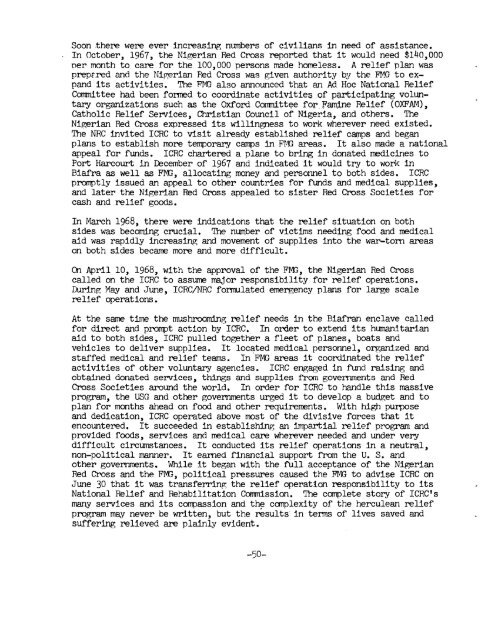3. - usaid
3. - usaid
3. - usaid
Create successful ePaper yourself
Turn your PDF publications into a flip-book with our unique Google optimized e-Paper software.
Soon there were ever increasing numbers of civilians in need of assistance.<br />
. In October, 1967, the Nigerian Red Cross reported that it would need $140,000<br />
ner month to care for the 100,000 persons made homeless. A relief plan was<br />
prep~red and the Nigerian Red Cross was given authority by the FT4G to expand<br />
its activities. The FPE also announced that an Ad Hoc National Relief<br />
Committee had been formed to coodinate activities of participating voluntary<br />
organizations such as the Oxford Comnittee for Famine Relief (OXFAM),<br />
Catholic Relief Services, Christian Council of Nigeria, and others. The<br />
Nigerian Red Cross expressed its willingness to work wherever need existed.<br />
The NRC invited ICRC to visit already established relief camps and began<br />
plans to establish more temporary camps in FrE areas. It also made a national<br />
appeal for funds. ICRC chartered a plane to bring in donated medicines to<br />
Port Harcourt in December of 1967 and indicated it would try to work in<br />
Biafra as well as FMG, allocating money and personnel to both sides. ICRC<br />
promptly issued an appeal to other countries for funds and medical supplies,<br />
and later the Nigerian Red Cross appealed to sister Red Cross Societies for<br />
cash and relief goods.<br />
In March 1968, there were indications that the relief situation on both<br />
sides was becoming crucial. The number of victims needing food and medical<br />
aid was rapidly increasing and movement of supplies into the war-torn areas<br />
on both sides became more and more difficult.<br />
01 April 10, 1968, with the approval of the FMG, the Nigerian Red Cross<br />
called on the ICRC to assm mjor responsibility for relief operations.<br />
During May and June, ICRC/NRC formulated emergency plans for large scale<br />
relief operations.<br />
At the same time the mushrooming relief needs in the Biafran enclave called<br />
for direct and prompt action by ICRC. In order to extend its humanitarian<br />
aid to both sides, ICRC pulled toether a fleet of planes, boats and<br />
vehicles to deliver supplies. It located medical personnel, organized and<br />
staffed medical and relief teams. I~'FE areas it coordinated the relief<br />
activities of other voluntary agencies. ICRC engaged in f'und raising and<br />
obtained donated services, things and supplies *om governments and Red<br />
Cross Societies around the world. In order for ICRC to handle this massive<br />
program, the USG and other governments urged it to develop a budget and to<br />
plan for months ahead on food and other requirements. With high purpose<br />
and dedication, ICRC operated above most of the divisive forces that it<br />
encountered. It succeeded in establishing an impartial relief program and<br />
provided foods, services and medical care wherever needed and under very<br />
difficult circumstances. It conducted its relief operations in a neutral,<br />
non-political manner. It earned financial support f'rom the U. S. and<br />
other governments. While it began with the f'ull acceptance of the Nigerian<br />
Red Cross and the FIG, political pressures caused the FMC; to advise ICRC on<br />
June 30 that it was transferring the relief operation responsibility to its<br />
National Relief and Rehabilitation Corrunission. The complete story of ICRC's<br />
many services and its compassion and the complexity of the herculean relief<br />
program may never be written, but the results in terms of lives saved and<br />
suff'erhg relieved are plainly evident.
















